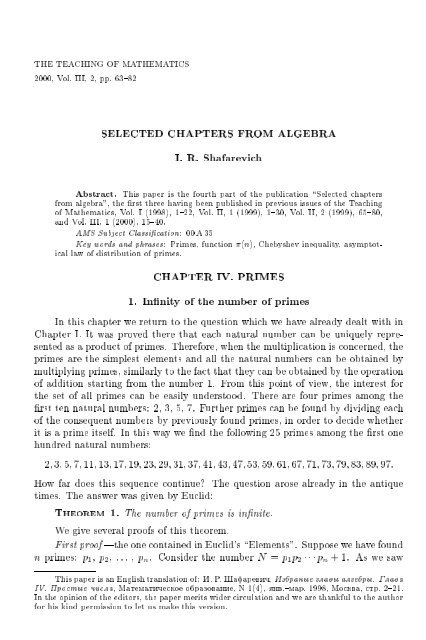SELECTED CHAPTERS FROM ALGEBRA I. R. Shafarevich Preface
SELECTED CHAPTERS FROM ALGEBRA I. R. Shafarevich Preface
SELECTED CHAPTERS FROM ALGEBRA I. R. Shafarevich Preface
Create successful ePaper yourself
Turn your PDF publications into a flip-book with our unique Google optimized e-Paper software.
THE TEACHING OF MATHEMATICS2000, Vol. III, 2, pp. 63{82<strong>SELECTED</strong> <strong>CHAPTERS</strong> <strong>FROM</strong> <strong>ALGEBRA</strong>I. R. <strong>Shafarevich</strong>Abstract. This paper is the fourth part of the publication \Selected chaptersfrom algebra", the rst three having been published in previous issues of the Teachingof Mathematics, Vol. I (1998), 1{22, Vol. II, 1 (1999), 1{30, Vol. II, 2 (1999), 65{80,and Vol. III, 1 (2000), 15{40.AMS Subject Classication: 00 A 35Key words and phrases: Primes, function (n), Chebyshev inequality, asymptoticallaw of distribution of primes.CHAPTER IV. PRIMES1. Innity of the number of primesIn this chapter we return to the question which wehave already dealt with inChapter I. It was proved there that each natural number can be uniquely representedas a product of primes. Therefore, when the multiplication is concerned, theprimes are the simplest elements and all the natural numbers can be obtained bymultiplying primes, similarly to the fact that they can be obtained by the operationof addition starting from the number 1. From this point of view, the interest forthe set of all primes can be easily understood. There are four primes among therst ten natural numbers: 2, 3, 5, 7. Further primes can be found by dividing eachof the consequent numbers by previously found primes, in order to decide whetherit is a prime itself. In this way we nd the following 25 primes among the rst onehundred natural numbers:2 3 5 7 11 13 17 19 23 29 31 37 41 43 47 53 59 61 67 71 73 79 83 89 97:How far does this sequence continue? The question arose already in the antiquetimes. The answer was given by Euclid:THEOREM 1. The number of primes is innite.We give several proofs of this theorem.First proof |the one contained in Euclid's \Elements". Suppose wehave foundn primes: p 1 , p 2 , ... , p n . Consider the number N = p 1 p 2 p n +1. As we sawThis paper is an English translation of: I. R. Xafareviq, Izbranye glavy algebry. GlavaIV. Prostye qisla, Matematiqeskoe obrazovanie, N1(4), nv.{mar. 1998, Moskva, str. 2{21.In the opinion of the editors, the paper merits wider circulation and we are thankful to the authorfor his kind permission to let us make this version.
















